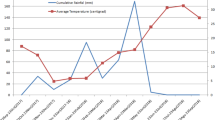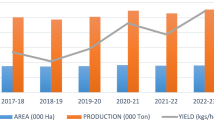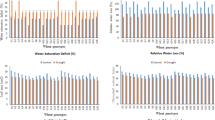Abstract
Drought stress is the major environmental constraint contributing to grain yield instability of wheat. In the present study, the recombinant inbred line population derived from DBW43/HI1500 cross was characterized for various morpho-physiological traits as well as grain yield stability analysis under moisture stress. The population was evaluated for grain yield under three different moisture stress environments viz., restricted irrigation, rainfed and late sown rainfed during the cropping season of year 2013–2014. Based on principal component analysis, the first five components explained over 60.40% of genetic variation. Grain yield per plot showed significant correlation with biomass and physiological traits viz., NDVI3, NDVI4, NDVI5, CT1, CT2 and CT3. The combined analysis of variance on grain yield data showed that mean squares of environments, genotypes and GEI were highly significant (p < 0.01). To determine effects of GEI on grain yield, data were subjected to AMMI and GGE biplot analysis, which identified G4, G69, G28, G67, G55 and G112 as the most stable and high yielding genotypes. Hence, the physiological traits NDVI and CT can be effectively used to screen out the line for drought tolerance. In addition, the stable wheat genotypes identified could be used in future wheat breeding programme.


Similar content being viewed by others
References
Ahmadi, J., Mohammadi, A., & Najafi Mirak, T. (2012). Targeting promising bread wheat (Triticum aestivum L.) lines for cold climate growing environments using AMMI and SREG GGE Biplot analyses. Journal of Agricultural Science and Technology, 14, 645–657.
Ayeneh, A., van Ginkel, M., Reynolds, M. P., & Ammar, K. (2002). Comparison of leaf, spike, peduncle and canopy temperature depression in wheat under heat stress. Field Crops Research, 79, 173–184.
Borrel, A. K., Hammer, G. L., & Henzell, R. G. (2000). Does maintaining green leaf area in sorghum improve yield under drought? II. Dry matter production and yield. Crop Science, 40, 1037–1048.
Breiman, A., & Graur, D. (1995). Wheat evaluation. Israel Journal of Plant Science, 43, 58–95.
Butron, A., Velasco, P., Ordás, A., & Malvar, R. A. (2004). Yield evaluation of maize cultivars across environments with different levels of pink stem borer infestation. Crop Science, 44, 741–747.
Cammarano, D., Fitzgerald, G., Basso, B., O’Leary, G., Chen, D., Grace, P., et al. (2011). Use of the canopy chlorophyl content index (CCCI) for remote estimation of wheat nitrogen content in rainfed environments. Agronomy Journal, 103, 1597–1603.
Campos, H., Cooper, M., Habben, J. E., Edmeades, G. O., & Schussler, J. R. (2004). Improving drought tolerance in maize: A view from industry. Field Crops Research, 90, 19–34.
Christopher, J., Richard, C., Chenu, K., Christopher, M., Borrell, A., & Hickey, L. (2015). Integrating rapid phenotyping and speed breeding to improve stay-green and root adaptation of wheat in changing, water limited, Australian environments. Procedia Environmental Sciences, 29, 175–176.
El-Hendawy, S., Al-Suhaibani, N., Salem, A. E. A., Rehman, S. U., & Schmidhalter, U. (2015). Spectral reflectance indices as a rapid and nondestructive phenotyping tool for estimating different morphophysiological traits of contrasting spring wheat germplasms under arid conditions. Turkish Journal of Agriculture and Forestry, 39, 572–587.
FAO. (2013). World food and agriculture. Statistical year book. Rome: Food and agriculture organization of the United States.
Farias, F. J. C., Carvalho, L. P., Silva Filho, J. L., & Teodoro, P. E. (2016). Biplot analysis of phenotypic stability in upland cotton genotypes in Mato Grosso. Genetics and Molecular Research, 15, 2.
Gauch, H. G. (1988). Model selection and validation for yield trials with interaction. Biometrics, 44, 705–715.
Hammer, Ø., Harper, D.A.T., & Ryan, P.D. (2001). PAST: Paleontological statistics software package for education and data analysis. http://palaeoelectronica.org/2001_1/past/issue1_01.htm. Accessed Aug 20, 2009.
Joshi, A. K., Mishra, B., Chatrath, R., Ferrara, G. O., & Singh, R. P. (2007). Wheat improvement in India: Present status, emerging challenges and future prospects. Euphytica, 157, 431–446.
Karimizadeh, R., Mohammadi, M., Sabaghni, N., Mahmoodi, A. A., Roustami, B., Seyyedi, F., et al. (2013). GGE biplot analysis of yield stability in multi-environment trials of lentil genotypes under rainfed condition. Notulae Scientia Biologicae, 5, 256.
Kaya, Y., Patla, C., & Taner, S. (2002). Additive main effects and multiplicative interactions analysis of yield performance in bread wheat genotypes a cross environments. Turkish Journal of Agriculture and Forestry, 26, 275–279.
Laffont, J. L., Hanafi, M., & Wright, K. (2007). Numerical and graphical measures to facilitate the interpretation of GGE biplots. Crop Science, 47, 990–996.
Lopes, M. S., & Reynolds, M. P. (2010). Partitioning of assimilates to deeper roots is associated with cooler canopies and increased yield under drought in wheat. Functional Plant Biology, 37, 147–156.
Lopes, M. S., Reynolds, M. P., Jalal-Kamali, M. R., Moussa, M., Feltaous, Y., Tahir, I. S. A., et al. (2012). The yield correlations of selectable physiological traits in a population of advanced spring wheat lines grown in warm and drought environments. Field Crops Research, 128, 129–136.
Mehari, M., Tesfay, M., Yirga, H., Mesele, A., Abebe, T., Workineh, A., et al. (2015). GGE biplot analysis of genotype-by-environment interaction and grain yield stability of bread wheat genotypes in South Tigray, Ethiopia. Communications in Biometry Crop Science, 10, 17–26.
Mishra, C. N., Tiwari, V., Satish-Kumar, V. G., Kumar, A., & Sharma, I. (2015). Genetic diversity and genotype by trait analysis for agro-morphological and physiological traits of wheat (Triticum aestivum L.). SABRAO Journal of Breeding and Genetics, 47, 40–48.
Mohammadi, R., Aghaee, M., Haghparast, R., Pourdad, S. S., Rostaii, M., Ansari, Y., et al. (2009). Association among non-parametric measures of phenotypic stability in four annual crops, Middle East. Russian Journal of Plant Science and Biotechnology, 3, 20–24.
Mohammadi, S. A., & Prasanna, B. M. (2003). Analysis of genetic diversity in crop plants: Salient statistical tools and considerations. Crop Science, 43, 1235–1248.
Olivares-Villegas, J. J., Reynolds, M. P., & McDonald, G. K. (2007). Drought-adaptive attributes in the Seri/Babax hexaploid wheat population. Functional Plant Biology, 34, 189–203.
Pask, A. J. D., Pietragalla, J., Mullan, D. M., & Reynolds, M. P. (2012). Physiological breeding II: A field guide to wheat phenotyping. Mexico, DF: CIMMYT.
Pinto, R. S., Reynolds, M. P., Mathews, K. L., McIntyre, C. L., Olivares-Villegas, J. J., & Chapman, S. C. (2010). Heat and drought adaptive QTL in a wheat population designed to minimize confounding agronomic effects. Theoretical and Applied Genetics, 121, 1001–1021.
Ramya, P., Singh, G. P., Jain, N., Singh, P. K., Pandey, M. K., Sharma, K., et al. (2016). Effect of recurrent selection on drought tolerance and related morpho-physiological traits in bread wheat. PLoS ONE, 11(6), e0156869.
Reynolds, M., Dreccer, F., & Trethowan, R. (2007). Drought-adaptive traits derived from wheat wild relatives and landraces. Journal of Experimental Botany, 58, 177–186.
Reynolds, M. P., Sayre, K. D., & Rajaram, R. (1999). Physiological and genetic changes in irrigated wheat in the post green revolution period and approaches for meeting projected global demand. Crop Science, 39, 1611–1621.
Salimi, S., Lahiji, H. S., Abadi, G. M., Salimi, S., & Moradi, S. (2012). Genetic diversity in soybean genotypes under drought stress condition using factor analysis and cluster analysis. World Applied Sciences Journal, 16, 474–478.
Samonte, S. O. P. B., Wilson, L. T., McClung, A. M., & Medley, J. C. (2005). Targeting cultivars onto rice growing environments using AMMI and SREG GGE biplot analyses. Crop Science, 45, 2414–2424.
Shukla, G. K. (1972). Some statistical aspects of partitioning genotype-environmental components of variability. Heredity, 29, 237–245.
Siahbidi, M. M. P., Aboughadareh, A. P., Tahmasebi, G. R., Teymoori, M., & Jasemi, M. (2013). Evaluation of genetic diversity and interrelationships of agro-morphological characters in durum wheat (Triticum durum Desf.) lines using multivariate analysis. International Journal of Agriculture, 3, 184.
Verma, A., Chatrath, R., & Sharma, I. (2015). AMMI and GGE biplots for G × E analysis of wheat genotypes under rain fed conditions in central zone of India. Journal of Applied and Natural Science, 7, 656–661.
Yan, W. (2001). GGE biplot: A windows application for graphical analysis of multi-environment trial data and other types of two way data. Agronomy Journal, 93, 1111–1118.
Yan, W. (2002). Singular-value partitioning in biplot analysis of multienviron-ment trial data. Agronomy Journal, 94, 990–996.
Yan, W., & Hunt, L. A. (2002). Biplot analysis of diallel data. Crop Science, 42, 21–30.
Yan, W., Hunt, L. A., Sheng, Q., & Szlavnics, Z. (2000). Cultivar evaluation and mega-environment investigation based on the GGE biplot. Crop Science, 40, 597–605.
Yan, W., & Kang, M. S. (2003). GGE biplot analysis: A graphical tool for breeders. In M. S. Kang (Ed.), Geneticists, and agronomist (pp. 63–88). Boca Raton, FL: CRCPress.
Yan, W., & Tinker, N. A. (2006). Biplot analysis of multi-environment trial data: Principles and application. Candian Journal of Plant Science, 86, 623–645.
Zobel, R. W., Wright, M. J., & Gauch, H. G. (1988). Statistical analysis of a yield trial. Agronomy Journal, 80, 388–393.
Author information
Authors and Affiliations
Corresponding author
Electronic supplementary material
Below is the link to the electronic supplementary material.
Rights and permissions
About this article
Cite this article
Harikrishna, Singh, G.P., Jain, N. et al. Physiological characterization and grain yield stability analysis of RILs under different moisture stress conditions in wheat (Triticum aestivum L.). Ind J Plant Physiol. 21, 576–582 (2016). https://doi.org/10.1007/s40502-016-0257-9
Received:
Accepted:
Published:
Issue Date:
DOI: https://doi.org/10.1007/s40502-016-0257-9




